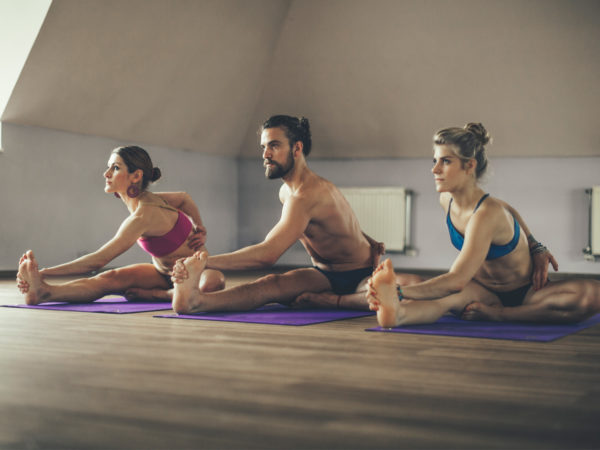Bikram Yoga: Too Hot To Handle?
What can you tell me about Bikram yoga that’s done in an extremely hot room? Is it safe?
Andrew Weil, M.D. | March 14, 2018

Bikram yoga is called “hot” for good reason: classes are held in rooms with the temperature set at 105 degrees Fahrenheit and the humidity controlled at 60 percent. It consists of 26 poses (asanas) designed to warm and stretch muscles, ligaments, and tendons in a specific order. Founder Bikram Choudhury maintains that the high heat is necessary to protect muscles and “allow for deeper stretching, to detoxify the body (by opening pores to let toxins out), to thin the blood to clear the circulatory system, to increase heart rate for a better cardiovascular workout, to improve strength by putting muscle tissue in an optimal state for reorganization, and to reorganize lipids (fat) in the muscular structure.”
While it’s true that warmer muscles are more flexible, making it easier to stretch, research published in 2018 showed that the health benefits of Bikram yoga have nothing to do with heat. The study, from Texas State University and the University of Texas, Austin, did find that Bikram yoga improved vascular health and may delay progression of risk factors for heart disease and stroke but did so whether it was practiced in rooms heated to 105 degrees or to a much more comfortable 73 degrees.
The investigators recruited 52 healthy but sedentary adults between the ages of 40 and 60 and assigned 19 of them to attend 90-minute Bikram yoga classes 3 times a week and 14 to take identical classes in a 73-degree room. The other 19 participants performed no yoga; they served as a control group.
After 12 weeks, the researchers assessed everyone’s vascular health by looking at changes in endothelial compliance – the ability of blood vessels to dilate in response to increased blood flow. They found beneficial changes among those in both yoga groups, indicating a lower risk of heart disease. Previous studies of the effects of hot yoga had shown similar improvements. No such changes occurred among those in the control group.
The only benefit seen among those who did hot yoga as opposed to the same routine in a cooler room was a relatively small but statistically significant decline in percentage of body fat.
These are welcome findings. I have concerns about exercising in high heat since it can be particularly stressful on the body (even for those who are very fit). It is also easier to overstretch heated muscles without being aware of it. Overstretching can lead to muscle strains or even damage to joints. If you have heart disease or are pregnant, I advise you to choose other types of yoga.
If you decide to try Bikram yoga in a hot room be sure to drink plenty of water throughout the routine and pay close attention to how you feel. Take a break if you find the poses too strenuous and stop immediately if you feel dizzy, lightheaded, overheated or experience chest pain. If you’re sensitive to heat and have experienced heatstroke or dehydration in the past, I suggest avoiding hot yoga. If you have arthritis or any type of joint problem or high (or low) blood pressure, be sure to check with your doctor before taking a Bikram yoga class.
Although I have reservations about this particular form, I believe that yoga in general is one of the best kinds of nonaerobic exercise. It can improve muscle tone, flexibility, and balance and also make you calmer and improve emotional and spiritual well-being.
Andrew Weil, M.D.
Source:
Stacy D. Hunter et al, “Effects of yoga interventions practiced in heated and thermoneutral conditions on endothelium-dependent vasodilation: The Bikram yoga heart study.” Experimental Physiology, January 18, 2018, DOI: 10.1113/EP086725









